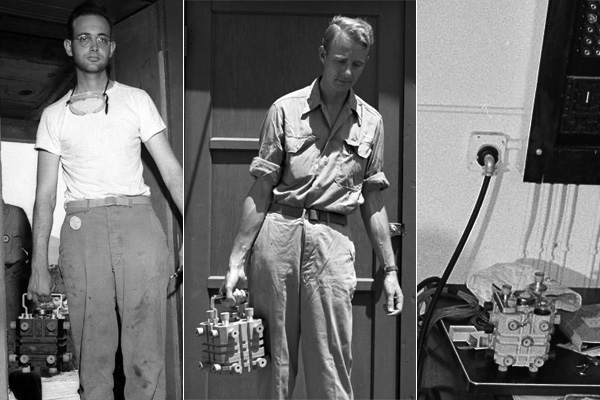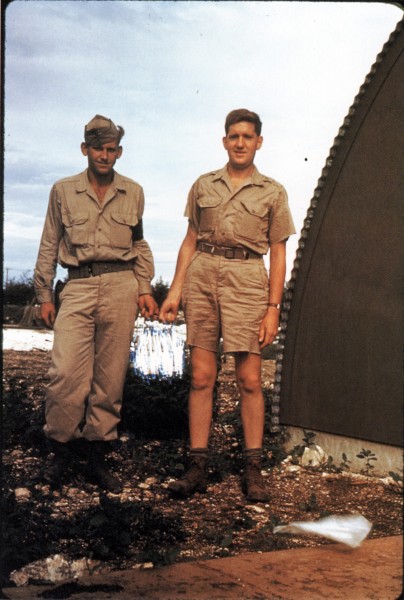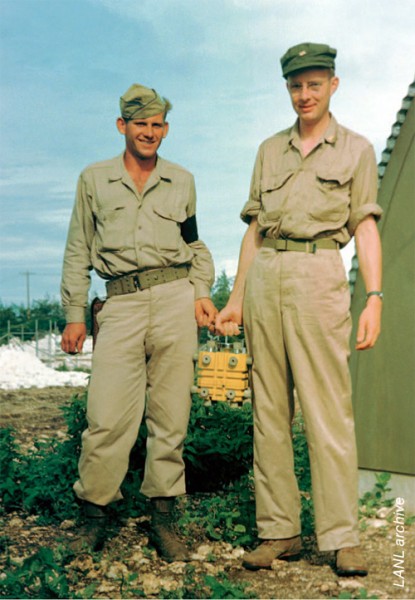I’ve found myself in a work crunch (somehow I’ve obligated myself to give three lectures in the next week and a half, on top of my current teaching schedule!), but I’m working on some interesting things in the near term. I have a review of Eric Schlosser’s Command and Control coming out in Physics Today pretty soon, and I’ll post some more thoughts on his book once that is available. And I have something exciting coming up for the 60th anniversary of Oppenheimer’s security hearing.
In the meantime, I wanted to share the results of one little investigation. I’ve posted a few times now (Posing with the plutonium, Little boxes of doom, The Third Core’s Revenge) on the magnesium boxes that were used to transport the plutonium cores used for the Trinity test and the Fat Man bomb:

The magnesium cases for the world’s first three plutonium cores. Left: Herb Lehr at Trinity base camp with the Gadget core. Center: Luis Alvarez at Tinian with the Fat Man core. Right: The third core’s case at Los Alamos, 1946.
Just to recap, they were a design invented by Philip Morrison (the Powers of Ten guy, among other things), made out of magnesium with rubber bumpers made of test tube stoppers. They could hold the plutonium core pieces (two in the case of the Trinity Gadget, three in the case of Fat Man), as well as neutron initiators. Magnesium was used because it was light, dissipated heat, and did not reflect neutrons (and so wouldn’t create criticality issues). All of this information is taken from John Coster-Mullen’s Atom Bombs, an essential book if you care about these kinds of details.
But all of the photographs of the box I had seen, like those above, were in black and white. Not a big deal, right? But I find the relative lack of color photography from the 1940s one of those things that makes it hard to relate to the past. When all of Oppenheimer’s contemporaries talked about his icy blue eyes, it makes you want to see them as they saw them, doesn’t it? Maybe it’s just me.
The only place where I almost saw a color photo of the box is in a photo that the late Harold Agnew had taken of himself on Tinian. It’s one of a large series of posing-with-plutonium photos that were taken on the island of Tinian sometime before the Nagasaki raid. Only this one is in color! Except… well, I’ll let the photo speak for itself:
Yeah. Not super helpful. This was scanned from Rachel Fermi and Esther Samra’s wonderful Picturing the Bomb book. They asked Agnew what had happened, and he told them that:
I was in Chicago after the war in 1946. The FBI came and said they believed I had some secret pictures. They went through my pictures and found nothing. Then like a fool I said, “Maybe this one is secret.” They wanted to know what that thing was. I told them and they said that it must be secret and wanted the picture. I wanted the picture so they agreed if I scratched out the “thing” I could keep the slide.
Thwarted by nuclear secrecy, once again! You can try to look extra close at the scratches and maybe just make out the color of the “thing” but it’s a tough thing to manage.
Ah, but there is a resolution to this question. Scott Carson, a retired engineer who posts interesting nuclear things onto his Twitter account, recently posted another photo of the box — in color and unredacted! His source was a Los Alamos newsletter from a few years back. It is of Luis Alvarez, another member of the Tinian team, in the same exact pose and location as the redacted Agnew photograph… but this time, un-redacted! And the color of the box was…
…yellow? Not what I was expecting.
Why yellow? My guess: it might be the same yellow paint used on the Fat Man bomb. Fat Man was painted “a mustard yellow rust-preventing zinc-chromate primer” (to quote from Coster-Mullen’s book) that made them easier to spot while doing drop tests of the casings.
The box for the Trinity core doesn’t look painted yellow to me — it looks more like raw magnesium. Maybe they decided that the tropical atmosphere of Tinian, with its high humidity, required painting the box to keep it from oxidizing. Maybe they just thought a little color would spruce up the place a little bit. I don’t know.
Does it matter? In some sense this is pure trivia. If the box was blue, green, or dull metallic, history wouldn’t be changed much at all. But I find these little excursions a nice place to meditate on the fact that the past is a hard thing to know intimately. We can’t see events exactly as they were seen by those who lived them. Literally and figuratively. The difficulty of finding out even what color something was is one trivial indication of this. And the secrecy doesn’t help with that very much.





Hi Alex – great post as always! How heavy was that box? From the degree that each person holding / carrying the box is leaning I’d say it was pretty heavy. And that really narrow handle doesn’t look too comfy to use for carrying it for long.
Hi Jan — I don’t know for sure, but we can guess. Magnesium is about 2/3rds as dense as aluminum, so it’s pretty light weight by itself. Guessing I’d say empty it would only be a couple of pounds, just making some rough assumptions about its size and density. But the plutonium core itself was very dense, and weighed some 13.6 lbs. So I think 15 lbs is probably a good round guess. If I were trying to balance a 15 lb dumbbell in a funny little box like that, I’d probably lean to offset the weight, but if I was trying to look cool (like Herb Lehr in the top left photo) I could probably pull it off without much of a lean.
That’s about the same weight as an adult cat. Or my adult cat. Another mystery solved!
When I was at the gym earlier this evening I decided to test whether it would make sense to lean to counterbalance a 15-pound weight. Not having ready access to plutonium cores, I had to make do with a dumbbell. What I found, to my slight surprise, was that not only was it unnecessary to lean to counterbalance that weight, it felt awkward to do so. Standing up straight was a more natural posture.
The Manhattan Project had standard worker compensation insurance, which only covered
illnesses or disabilities that appeared within 90 days of an accident or 30 days after
leaving the project. But Cyril Stanley Smith, chief metallurgical chemist at Los Alamos,
denounced it as “inhumane, unethical and unfair,” as he and his fellow chemists refused
to work without extra insurance. Bending to their wishes, the U.S. government set up a
secret one million dollar fund for the plutonium chemists at Los Alamos.
Ordinary workers in the Manhattan Project fared less well. Ted Lombard was an enlisted
man in the U.S. Army assigned to work at the Los Alamos Laboratory during the war
who recalled less-than-ideal working conditions:
“We used to go to Fort Douglas, Utah in ambulances, [to] pick up uranium and
plutonium. We carried dosimeter badges in our pockets because you couldn’t
display them. . . . Then [after the badges were turned over to an officer] we would
proceed to unload uranium and plutonium barehanded . . . the fumes and dust
were constantly in the air; there was no ventilation system. The dust was on the
floor. Uranium chips would be in your shoes that you continued to wear. You
went to eat with the same clothes on. You went to the barracks with the same
clothes and sat on the beds. . . .”
Given widespread exposure problems, concerns over financial and legal liabilities also
influenced radiation protection decisions. An overriding concern according to Stafford
Warren, medical advisor to General Leslie Groves, military chief of the Manhattan
Project, was to protect “the government interests” against legal claims.
By 1980, Ted Lombard was suffering from fibrosis of the lungs, severe bone marrow and
blood forming organ damage. Four of his five children born after working at Los Alamos
had severe medical problems, including neuromuscular and blood disorders. When
Lombard filed a claim with the U.S. Department of Veterans Affairs, he was denied
repeatedly on the grounds that his medical and exposure records were missing.
The photo from Trinity Base Camp reminded me that their idea of a “clean room” to assemble the first atomic bomb test was a few sheets of visqueen taped over the windows and a sign that read “Please remove your shoes.” We’ve come a long way, baby.”
Institutions develop institutional colors.
Just as the walls of hospital rooms the world over in those days were all painted a particular shape of hospital green – so too uranium signage became mat black on a bright mustard yellow.
So the yellow bomb casing and plutonium carryall were at least consistent with their institutional colouring……
I was thinking the same thing. Natural uranium is a yellow color and so perhaps the use of yellow was to denote radioactivity. Later on, the US used yellow on all of it’s government issued civil defense instruments, and the practice continues on some government radiation detection equipment used by FEMA to this day. The Soviets, however, didn’t seem to have any color convention with regards to this sort of thing and their instruments came in a variety of colors. Most notably, they were either a brown plastic or green plastic (DP-5 series geiger counter kit).
I suspect the yellow was more for visibility if they lost a container. The Air Force used various shades of yellow as a visibility tool on ground equipment into the 1980s – including large things like snowplows and refueling and demineralized water trucks. Cluster bomblets are still yellow (the outer containers are gray).
I think they might have painted one yellow just so they wouldn’t get the boxes mixed up. There is such a disarming amount of charm in these DIY carrying cases.
Yellowcake is in fact rarely yellow , just as Yellowmagic, (wartime partially purified penicillin) was rarely yellow.
So now a few suggestions why, despite this ,that they BOTH got tagged with the colour combo of black letters on saturated yellow background. (Seriously wounded soldiers requiring frequent penicillin injections had toe-tags in black on yellow indicating this.)
Studies indicate black on yellow offers the human eye the maximum contrast and shouts “look at me !”
The original penicillin droplets on the mass of grey green penicillium mold are golden yellow and again the visual contrast is so striking once seen that it is rarely forgotten and seems to have been mentally carried through to the actual early dirty red-brown penicillin powder.
But yellow signifies not just the valued element gold , it signifies the life-giving sun, and some of this seems to carry over to the way we admire and seek out the most golden yellow of butter, honey and corn. (Because neither corn nor honey needs be very yellow.)
I think the mental track went like this : Penicillin gives life , the sun gives life. And atomic fission energy sort of promised to unlock the power of the life-granting sun -something the reality of fusion would definitely do.
Spencer Weart was the type of scholar to look into such barely conscious mental connections.
The wartime overlap between yellowcake and yellowmagic are many and fascinating.
Be interesting to see someone mock one of these up in the machine shop.
If someone wanted to take a stab at designing it from the photos I could see about casting it when I got to California in the fall. Seems like a part of history that should exist, even if only in replica form, somewhere.
The rubber flask-stopper “bumpers” haven’t changed, so at least that should be easy.
As soon as I saw the photos I thought of the launch-code “football”:
http://a.abcnews.go.com/images/WNT/abc_wn_donvan_101020_wg.jpg
It looks like they’re not all identical.
On the one Herb Lehr is holding the vertical grooves don’t go all the way to the bottom and on the third core box there is an extra stopper in the middle.
That said, certain design elements are consistent. The boxes appear to be identical on all four sides, and nearly so on the bottom. The corners are beveled at a 45 degree angle, and there appears to be a seam about a third of the way up.
There were probably knocked together by the Los Alamos machinists from hand drawn plans by Morrison and as such there were probably no blueprints. We know that what goes in them is a sphere about six inches in diameter, and that the sphere needs to be supported in all axis.
I dunno, I’m curious. I’ll play with this a little.
They also had holes on the corners for holding initiators. John Coster-Mullen has collected a number of photos of the cases. Here is an unusual view of the one present at the Slotin accident, for example. It gives a hint about how the initiator containers worked.
Oh — and the plutonium cores were a lot smaller than 6″ in diameter! The diameter for them was only 3.62″ (9.2 cm). The initiator diameters were 0.79 inches (2 cm).
OK the Slotin picture answers some questions.
Best guess from looking at the pictures is that the boxes are split into a top and a bottom about a quarter to a third of the way up. It looks like there are four bolts, I’m arbitrarily calling them 1/4 inch, that pass down through the top of the box and thread into the bottom section. The bolts appear to be located in the middle of each side of the box, rather than at the corners which leaves room for the initiators. The reason that the box is split a third of the way up from the bottom rather than at the middle is that this would leave more room in the upper section so that the core can be removed without disturbing the initiators.
Judging by the Slotin picture, 1/4 is probably the upper end of the thickness of the top of the box. If we assume that the sides in the “grooves” are the same that puts the maximum thickness of the sides at about 1/2 inch. Regarding the discussion of weights above, I would guess a total of closer to 20 pounds total is probably closer, with 14 lbs of plutonium and 5-6 pounds of box.
Best I can tell the rubber stoppers on the outside are there to act as primitive bumpers and aren’t matched by anything on the inside of the box. If the studs that the outer stoppers were mounted on passed through the wall of the box they would interfere with where the initiator tubes need to go.
I’ll see if I can start working on some drawings of this and maybe see about casting it when I go to CA later this year. Maybe Alex can get one under his Christmas tree from his readers.
So I found a good description of the case. It is from Ralph Sparks’ book, _Twilight Time: A Soldier’s Role in the Manhattan Project_. Sparks was the one who made the case from Morrison’s design. Rather than type it all out, here’s the relevant section from the Amazon preview. It clarifies a few things.
The Gadget core box does not appear to be yellow – even though the picture with Sgt Lehr is black and white, it seems to be of a much darker hue.
The Trinity box is also a different design, so it makes sense that it might have been painted a different color. The box Lehr is holding was probably something of a prototype for the boxes that went to the Pacific.
One more color hypothesis: The box migh have been cadmium-coated as an extra security measure. Cadmium-113 is a neutron absorber.